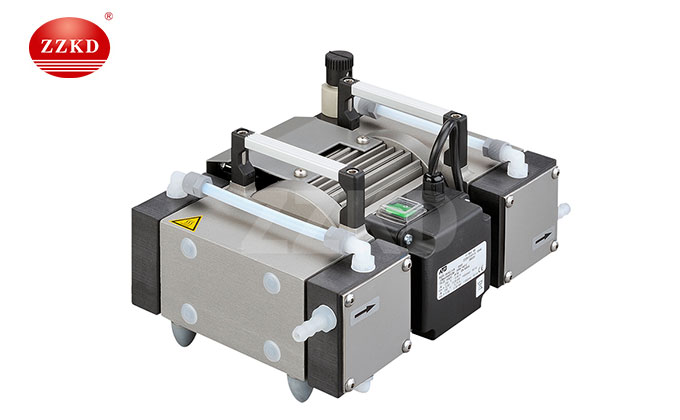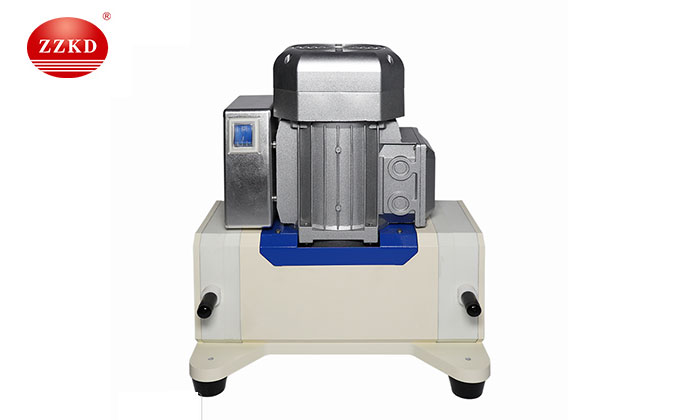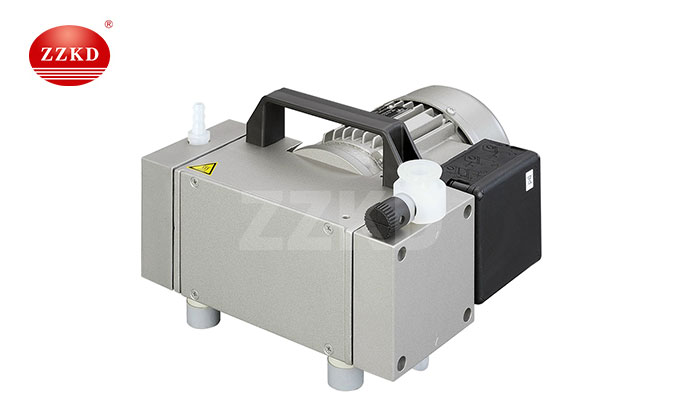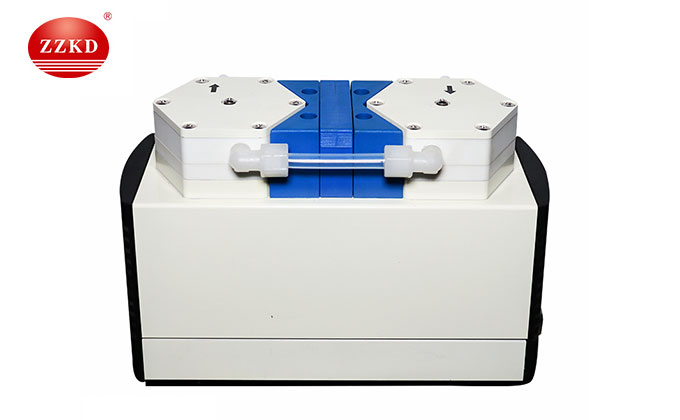Diaphragm vacuum pump is a special form of positive displacement pump. It relies on the back and forth agitation of a diaphragm to change the volume of the working chamber to inhale and discharge liquid. The pneumatic diaphragm vacuum pump is mainly composed of two parts: the transmission part and the diaphragm cylinder head. The transmission part is the driving mechanism that drives the diaphragm back and forth. Its transmission forms include mechanical transmission, hydraulic transmission and pneumatic transmission, among which hydraulic transmission is widely used. The working part of the diaphragm vacuum pump is mainly composed of a crank connecting rod mechanism, a plunger, a hydraulic cylinder, a diaphragm, a pump body, a suction valve and a discharge valve, etc. Among them, the driving mechanism composed of a crankshaft connecting rod, a plunger and a hydraulic cylinder and a reciprocating Piston pumps are very similar.
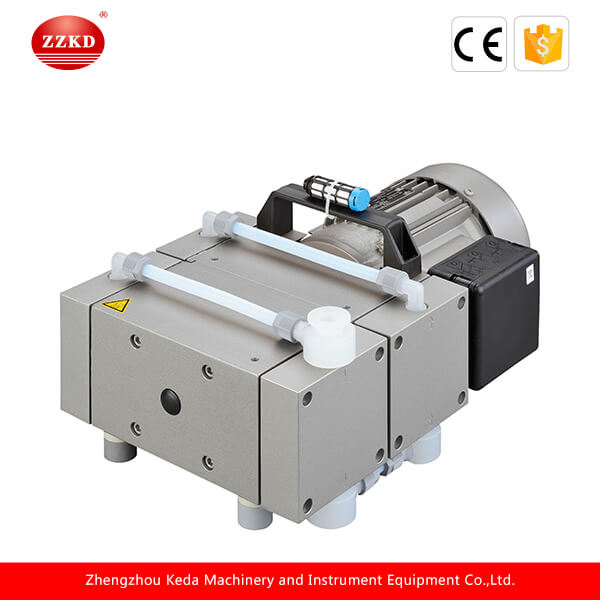
Diaphragm vacuum pump, also known as control pump, is the main type of actuator, which accepts the control signal output by the modulation unit. Diaphragm vacuum pumps operate by power to vary fluid flow. Diaphragm vacuum pumps are made of four materials: plastic, aluminum alloy, cast iron, and stainless steel. Diaphragm vacuum pumps use nitrile rubber, neoprene, fluororubber, polyvinylidene fluoride, and polytetrahexaethylene according to different liquid media. to meet needs. It is placed in various special occasions and used to pump various media that cannot be pumped by conventional pumps. It is especially suitable for rotary evaporators and basically meets the requirements of conventional solvents.
Laboratory diaphragm vacuum pumps are widely used in scientific research, medical treatment, instrumentation, chemical analysis, bioengineering, automatic control, environmental protection, water treatment and many other fields. Especially the laboratory diaphragm vacuum pump, most laboratory equipment will be equipped with a vacuum pump, because the vacuum pump is not a single device, it can be used in conjunction with other instruments. Such as vacuum filtration, microbial detection, waste liquid extraction, rotary evaporator, vacuum drying oven, freeze dryer and other equipment. Vacuum pumps are auxiliary equipment for every laboratory.
Working Principle of Diaphragm Vacuum Pump:
Diaphragm vacuum pumps are commonly used equipment in laboratories and are often used in conjunction with rotary evaporators. The simple working principle of the diaphragm vacuum pump is: the circular motion of the motor makes the diaphragm inside the pump reciprocate through the mechanical device, thereby compressing and stretching the air in the pump cavity to form a vacuum, and creating a pressure difference between the suction port and the external atmospheric pressure , Under the action of pressure difference, the gas is sucked into the pump chamber and then discharged from the exhaust port.
Diaphragm Vacuum Pump Model:
ZZKD Machinery has been focusing on R&D and production of diaphragm vacuum pumps for many years. Diaphragm vacuum pumps are one of our main products. After many upgrades, the models and types of diaphragm vacuum pumps have become more and more perfect, and their functions have become more and more perfect. Diaphragm vacuum pumps are available in two series: DP series and MPC series.
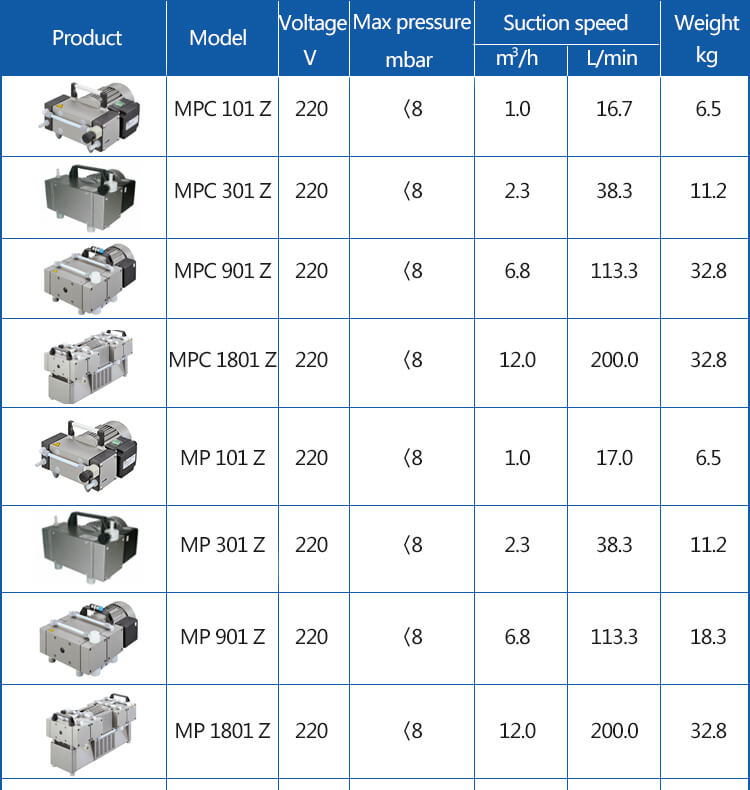
Diaphragm Vacuum Pump Structure:
The diaphragm vacuum pump is mainly composed of two parts: the transmission part and the diaphragm cylinder head.
The transmission part is the driving mechanism that drives the diaphragm back and forth. Its transmission forms include mechanical transmission, hydraulic transmission and pneumatic transmission, among which hydraulic transmission is widely used. The working part of the diaphragm vacuum pump is mainly composed of a crank connecting rod mechanism, a plunger, a hydraulic cylinder, a diaphragm, a pump body, a suction valve and a discharge valve, etc. Among them, the driving mechanism composed of a crankshaft connecting rod, a plunger and a hydraulic cylinder and a reciprocating Piston pumps are very similar.
When the diaphragm vacuum pump is working, the crank linkage mechanism drives the plunger to reciprocate under the drive of the motor, and the movement of the plunger is transmitted to the diaphragm through the working liquid in the cylinder, so that the diaphragm agitates back and forth. The diaphragm must have good flexibility and good corrosion resistance, usually made of polytetrafluoroethylene, rubber and other materials. The pot-bottom-shaped parts with mesh holes on both sides of the diaphragm are set to prevent excessive local deformation of the diaphragm, and are generally called diaphragm limiters. Pneumatic diaphragm vacuum pumps have good sealing performance and can easily achieve leak-free operation. They can be used to transport corrosive liquids such as acids, alkalis, and salts, and high-viscosity liquids.
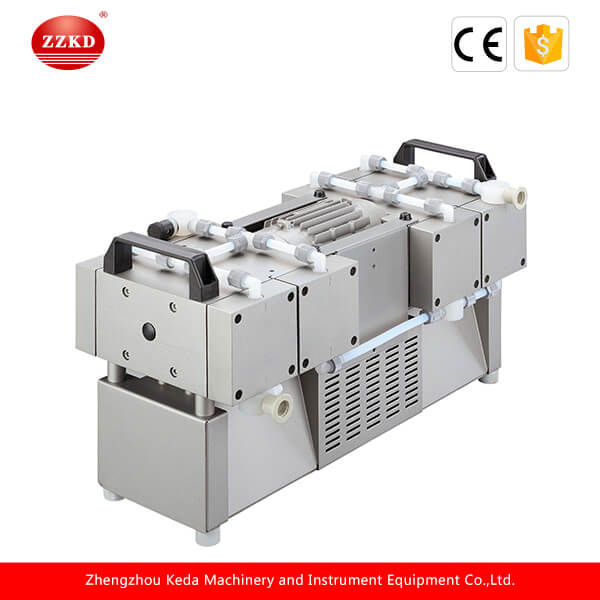
How to Use a Diaphragm Vacuum Pump:
Take the application of diaphragm vacuum pump in rotary evaporator as an example:
1. Put the diaphragm vacuum pump on the operating table stably, and connect the rotary evaporator and the vacuum pump tightly to ensure that the system has good airtightness.
2. Turn on the power switch. When the vacuum pump is connected to an external load, the pointer of the vacuum gauge turns counterclockwise. When the vacuum pump reaches the maximum working pressure, turn the adjusting knob clockwise to turn on the power. When the pump is working normally, the required working pressure can be obtained by adjusting the knob.
3. Inflating operation: Before the operation of the diaphragm vacuum pump, inflate the air chamber first, the air pressure is greater than the working pressure of the pump, and the diaphragm vacuum is driven
Adjust the pump to the working pressure. At this time, you can see the water outlet hose of the pump shaking violently; take a needle and press it against the air nozzle to deflate. With the progress of deflation, the shaking phenomenon of the outlet hose will gradually disappear; the outlet hose When it is stable, stop deflation.
4. Adjust the height and rotation speed of the distillation flask with the rotary evaporator, set the appropriate water bath temperature, stop the rotation after steaming, then ventilate the atmosphere, then stop the water pump, and finally remove the distillation flask
5. Pressure system operation: the instrument air and lubricating oil pressure of the diaphragm vacuum pump are interlocked with the main motor. The instrument air is also kept on to avoid insufficient or excessive liquid in the propelling liquid cavity. The air supplied to the valve is filtered and oil atomized.
6. After filtering, turn off the power.
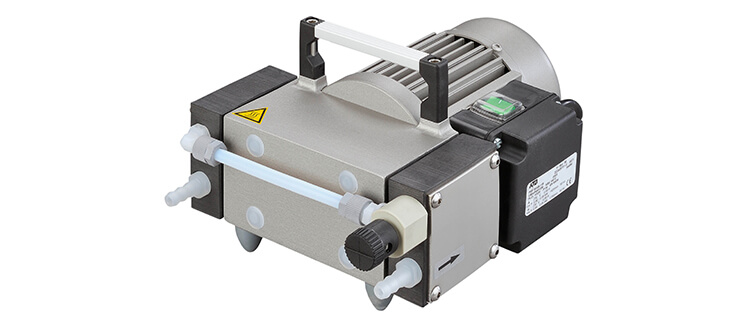
Diaphragm Vacuum Pump Features:
1. The diaphragm vacuum pump can absorb various corrosive liquids, liquids with particles, high viscosity, volatile, flammable and highly toxic liquids.
2. Diaphragm vacuum pumps use air as power and are suitable for medium to high viscosity fluids.
3. The diaphragm vacuum pump has no rotating parts and no shaft seal. Environmental pollution and personal injury are avoided.
4. The diaphragm vacuum pump is small in size, easy to move, occupies a small area, and is easy to install.
5. The diaphragm vacuum pump has a simple structure and is easy to install and maintain.
6. Diaphragm vacuum pump can be immersed in the medium instead of submersible pump to pump liquid.
7. It has good fluidity, allows particles with large diameters to pass through, can transport various liquids, and has little wear on the pump when pumping mud and impurities.
Diaphragm Vacuum Pump Precautions:
1. Ensure that the largest particle contained in the fluid does not exceed the maximum safe particle diameter standard of the pump.
2. The intake pressure should not exceed the maximum allowable operating pressure of the pump. Compressed air with a pressure higher than the rated pressure may cause personal injury and property loss and damage the performance of the pump.
3. Ensure that the pipeline system of the pump pressure can withstand the highest output pressure achieved, and ensure the cleanliness and normal working conditions of the driving air system.
4. Static sparks may cause explosions, resulting in personal casualties and property losses. Use wires with a sufficiently large cross-sectional area as required to properly and reliably ground the grounding screw on the pump.
5. The grounding requirements are in compliance with local laws and regulations and some special requirements on site.
6. Fasten the pump and the connecting pipe joints to prevent static sparks from vibration, impact and friction. Use antistatic hose.
7. To periodically check and test the reliability of the grounding system, the grounding resistance is required to be less than 100 ohms.
8. Keep good exhaust and ventilation, keep away from flammable, explosive and heat sources.
Why Choose Us
Professional drying equipment manufacturer
ZZKD Mechanical Instrument Equipment Co., Ltd. is a company integrating production and trade. Our main product is vacuum pump equipment. Diaphragm vacuum pump is one of our main products for sale. Our diaphragm vacuum pump models are: DP series and MPC series. At the same time, we can also customize according to your needs. The company has been established for more than ten years, providing equipment solutions for tens of thousands of enterprises and individuals at home and abroad, and has won unanimous praise from domestic and foreign customers.
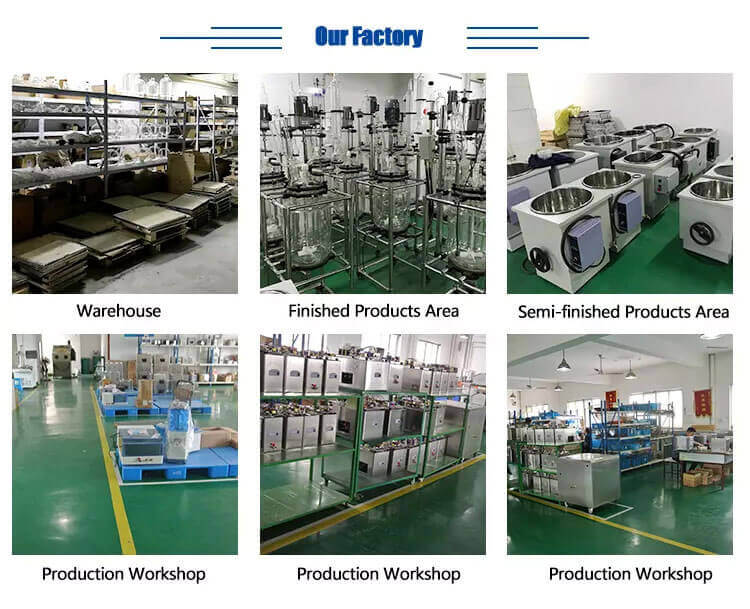
Fast delivery
We have warehouses in Los Angeles in the United States, Valencia in Spain, and Thailand. We can choose the nearest warehouse for delivery according to the customer's geographical location, ensuring that the customer receives the goods quickly.
Perfect after-sales team
We provide a one-year warranty service for the products we sell. We have a professional after-sales team to deal with customers' after-sales problems, and can provide corresponding technical guidance through videos and other methods.
Parameter
Model | Voltage (V) | Ultimate vacuum (mbar) | Flow rate (m3/h) | Flow rate (L/min) |
MPC301Z | 220 | 2.3 | 38.3 | |
MPC302Z | 220 | 2.6 | 43 | |
MPC201T | 220 | 2.0 | 33.3 | |
MPC601T | 220 | 3.9 | 65 | |
MPC602T | 220 | 3.9 | 65 | |
MPC1201T | 220 | 8.3 | 138 |
Model | Voltage (V) | Ultimate vacuum (mbar) |
MPC301Z | 220 | |
MPC302Z | 220 | |
MPC201T | 220 | |
MPC601T | 220 | |
MPC602T | 220 | |
MPC1201T | 220 |

